| Pages:
1
2 |
palico
Hazard to Self
 
Posts: 59
Registered: 1-10-2013
Member Is Offline
Mood: No Mood
|
|
@ Sir Gawain: Take in count this hydrolysis is very sensitive to acid concentration. Once I attempted hydrolysis in 50% sulfuric acid, heated to more
than 100 Celsius overnight, got no hydrolysis at all.
@Rainwater: the smell can be glyoxal.
@ j_sum1: you can convert it to its diethyl ester. I made a post about.
@Texium: The diethyl ester can be used as high boiling solvent.
|
|
|
Boffis
International Hazard
    
Posts: 1837
Registered: 1-5-2011
Member Is Offline
Mood: No Mood
|
|
The best way forward to interesting derivative from terephthalic acid is to nitrate it as per kmno4 posts in erlier threads on terephthalic acid from
PET. From this can be prepared aminoterephthalic acid, the acetanidilide and then to a whole raft of compounds but this area of chemistry is not well
explored.
|
|
|
kmno4
International Hazard
    
Posts: 1495
Registered: 1-6-2005
Location: Silly, stupid country
Member Is Offline
Mood: No Mood
|
|
Having some free time, I decided to try patent (US4355175) procedure, just for sheer fun.
It means 10g of PET (bottle, colorless) + 18g of conc. H2SO4 + 2g of H2O.The mixture soon becomes syrupy and pinkish. After initial heat effect
(H2SO4+H2O), it was kept at ~30 C during few days. The mixture becomes more and more sticky, some white sediment is formed, surely TPA.The weak odour
of the mixture reminds me experiments with H2SO4 and EtOH, most possibly some kind(s) of "glycolhydrogensulfate" and/or etheric products are formed.
No 1,4-dioxane odour is detected at this stage and later. Visibly, some PET praticles dissolved.
The sticky mixture was transfered into beaker with water (heat is generated). Colorless, coloidal solution is formed with white sediment and unreacted
PET. It was heated for some time, solution becomes transparent, some PET-gel precipitates (looks like ion-exchange resin), but not much. The solution
was then filtered, filtrate was kept.
The sediment was washed with NaOH solution, boiled, filtered and TPA precipitated with saved earlier acidic filtrate. About 4g of TPA was obtained.
The PET-based slightly brownish residue (~6g) was dried and reused for alkaline hydrolysis.
Alkaline hydrolysis.
13 g of PET (cut bottle, ~ 0,5 cm x 0,5 cm pieces) was placed in a screw-top glass jar, 10 g of NaOH (small granules) and 10 g of water are added. The
jar (closed) was then heated on water bath (almost boiling) for several hours. Slowly, gradually, PET hydrolyses, white sediment is formed (TPA Na
salt), the mixture becomes semi-solid mud. From time to time, the jar is tapped by hand to obtain more uniform mixture.
At the end of reaction (or your patience), when PET particles ar not visible, the jar is cooled, the mixure is dissolved in ~200 cm3 of water, heated,
filtered, some acid is added (e.g. citric)... etc. When time of NaOH treatment is long enough, conversion of PET into TPA is practically 100%, but it
also depends on input PET form*. The reaction can be easily scaled up, without any problems, time of NaOH treatment remains the same.
Some publications suggest the use of KOH, as better "solvent" for PET than NaOH - it was also tried.
11 g of PET + 10 g of KOH (commercial, ~90%) + 10 g of water and the rest as above. The reaction is much faster than with NaOH, the reaction mixture
is also much less thick. It is caused partly by better TPA K salt solubility, but the main reason is "just" larger KOH activity. It is another proof,
that conc. NaOH is not repacement for conc. KOH.
In one experiment, the end-white-mud was added to partly reacted PET+NaOH mixture. Effect was almost the same as in case of PET+KOH only reaction: PET
particles disinegrate much faster in NaOH+KOH mixture than in NaOH only... interesting.
I am going to make some titration of prepared TPA, but my standard NaOH solution is almost out. I have to buy or prepare it.
* a radical improvement in shortening of time of PET hydrolysis is using "powdered" PET. It can be done with
stright saw-blades (several such blades joined in prarallel) and PET plactic. The best for this purpose are the thickest parts of PET bottles : tops
and bottoms. Obtaining this "powder" in such way, manually, is very boring job, possibly it can be done with some mechanical tools. However, time of
reaction with PET-powder is about 1/10 of reaction time with PET-cut material, also in case of less concentrated alkali.
Additional notes.
1)When at some stage, water solution of TPA salt is colored, the coloration possibly can be removed by small amout of sodium percarbonate on cold. It
is important, becuse in hot solutions percarbonate decomposes itsef, without acting on colored impurities.
2)In each case of akaline hydrolysis, weak alkoholic odour of glycol is sensible. With KOH, small brownish layer is present on top of post-reaction
mud. But its recovery is much more time consuming than TPA.
3) Experiments with PET + molten citric acid and PET + molten urea were conducted. Unfortunately, PET remains unchanged, at least during few minutes
and near melting point.
Слава Україні !
Героям слава !
|
|
|
Texium
Administrator
       
Posts: 4516
Registered: 11-1-2014
Location: Salt Lake City
Member Is Offline
Mood: PhD candidate!
|
|
What were your yields of TPA from the NaOH and KOH hydrolysis runs?
|
|
|
palico
Hazard to Self
 
Posts: 59
Registered: 1-10-2013
Member Is Offline
Mood: No Mood
|
|
@kmno4: have you confirmed your product be TPA ?
|
|
|
kmno4
International Hazard
    
Posts: 1495
Registered: 1-6-2005
Location: Silly, stupid country
Member Is Offline
Mood: No Mood
|
|
Having again some free time, another alkaline hydrolysis experiment was performed to test slightly lower hydroxide loading.
This time, doomed to destruction was 1 liter PET bottle (=PB), containing earlier canola oil. The PB was washed inside with detergent several times,
but very weak odour of the oil was still present after drying. However, the PB was clean, with traces of some glue (from label). The top-part and the
bottom-part of the PB were "powdered" as given above, the rest was cut ( shears for steel sheets are very good for this purpose). In this way, 23 g of
pre-depolimerized PET was obtained.
A jar, ~160 cm3 (as above) was taken, the PET was paced inside, 8 g of KOH (old) and 8 g of NaOH (very old) were added to the jar, mixed and 16 g of
water was added. Nothing interesting happens, some heat is generated, that is all. The bulk volume of the starting mixture does not exceed 50% vollume
of the jar. The jar is then immerced in water bath (as above). During 2-3 hours of heating, whitish mud is formed, most of PET disappers. Aftrer this
time, inspection reveals unreacted PET particles inside the mud. Additional ~5 hours heating was applied, but still some PET was present. The jar was
cooled, the mud was transferred into some beaker with water (200-300 cm3). It was heated until all salts are dissolved. Some brownish scum was
present, some PET particles separates, the liquid is clean and slightly yellowish. It was then filtered. The amount of brownish scum was very small,
the PET was separated and dried. It looks like ~5 g, but in reality it was 1,7 g. To the clean water filtrate, some acid was added to precipitae TPA.
White suspension is formed. It was heated up to boiling (shortly) and filtered.
The filtered, washed many times with warm water and dried crude (but white) TPA weighs 17,5 g.
ps. the mass of the jar before and after heating was exactly the same
PS.
Standard NaOH solution was prepared and a sample TPA from previous runs (combined) was titrated. Assuming that it is dibasic acid, calculated molar
mass is 165,3.
Titration of a sample of crude TPA from the last run (17,5 g ) gave M=165,7. It means that some mysterious "oligomers" exist only in the doubters'
minds.
[Edited on 3-3-2024 by kmno4]
Слава Україні !
Героям слава !
|
|
|
bnull
Hazard to Others
  
Posts: 150
Registered: 15-1-2024
Location: Between the Atlantic and the Pacific Ocean
Member Is Online
Mood: Sleepy (again)
|
|
I want to add my five kopeks to the discussion. I read some weeks ago a paper (Towards closed-loop recycling of multilayer and coloured PET plastic waste by alkaline hydrolysis) that proposed a procedure with conditions so
mild that I was tempted enough to tryNote 1. It was February 7th, I believe (I don't keep track of trial runs).
First of all, I don't have a NMR spectroscope, so don't expect to see fancy graphs with well formed TPA peaks. I'll take some pictures of the products
in two weeks (give or take a week) and post here.
The procedure was the following. According to the authors, the optimal conditions for PET hydrolysis are met by a solution of ethanol in water (60
vol% EtOH, 40 vol% water) with 5% in weight of NaOH. The temperature should be kept at 80°C. For 10 mL of solutionNote 2, I first
dissolved 0.5 g of NaOH in 1 mL of water and completed to 4 mL. To that were added 6 mL of ethanol azeotrope (96.5%). The solution was moved to a
glass bulb heated in a water bath (a paint can with water at 90°C) until equilibrium.
A strip (about 3 g) of PET, kindly donated by a water bottle and previuosly cut into pieces of 5 mm or less, was added at this moment. I waited about
2 minutes and removed the flask from the bath. To my surprise, the pieces of plastic showed signs of attack. They presented fine parallel grooves, as
if they had been sandpapered.
It was at this moment that the ghost of Gergel intervened. While adjusting the height of the support, my hand slipped and the flask tumbled, spilling
about half of the solution. I gave up, transferred the remaining solution and the pieces of PET to a small polypropylene vial, which is in my drawer,
and cleaned the place.
Two or three days later, some of the plastic fragments had a white mass growing at the corners: sodium terephthalateNote 3 had formed.
Yesterday, I looked again. The growth slowed considerably, and small crystals appeared in the bottom of the vial. They are similar in appearance to
fine table salt or boric acid. As the reaction is still going on, albeit very slowly, I'll leave the vial as it is, except for a piece of etched PET
and a grain from the white mass.
Note 1: My lab has been languishing in neglect for some years since I begun studying Physics. Few
reagents left and very crude equipment. My own fault, you see. Nevermind.
Note 2: The quantities are slightly off because the NaOH absorbed some water from the air (rainy day)
and the volume of alcohol-water solutions is always less than it should be. Let's ignore the small difference (0.2 mL perhaps) and say the volume was
10 mL.
Note 3: It may be either disodium terephthalate or a sodium salt of some oligomer. If we may judge
from the solubility in water, it is the disodium TPA salt. And the oligomer salt (sodium-terephthalic acid-glycol-terephthalic acid-sodium, for
example) would have been attacked by the dissolved hydroxide anyway. I'll pyrolise a sample to see what happens.
[Edited on 2-3-2024 by bnull]
Quod scripsi, scripsi.
B. N. Ull
P.S.: Did you know that we have a Library?
|
|
|
kmno4
International Hazard
    
Posts: 1495
Registered: 1-6-2005
Location: Silly, stupid country
Member Is Offline
Mood: No Mood
|
|
... and the last PET destruction experiment was performed, to test another idea.
Intensively green-colored PB, with rather thick walls, was cut and powdered (as above). 25,5 g of obtained PET crumbs were placed in the jar (as
above) with 8,2 g of KOH + 8,2 g of NaOH + 17 g of water. The jar was covered with watch glass and placed in microwave oven. The power was set at 90 W
and 2-4 minutes. After several heating cycles, white-blue mud is formed, bulk volume of the input decreases. From time to time, the mass of the jar is
checked, if the mass loss is greater than 2-3 g (evaporation), appropriate amount of water is added to keep total mass constant (more or less). Also
from time to time, the content of the jar is mixing with some rod, to keep the mass as uniform and compact as possible. Finally, all PET particles are
suspended in the mud. It is heated for some time longer, as hydroxides are consumed, the reaction becomes slower and slower. I had no time for it, the
colored mud was transferred to the beaker with water and heated (as bove). Obtained liqiud was intensively green-blue colored, but inspection reveals
that the dye forms "clouds". The liquid was filtered, giving clear yellowish solution, deep blue sediment (looks like Prussian blue) in small yiled
and ~5.7 g of green PET chips. After earlier experiments, 4,2 g of colored TPA was left and it was added to the solution. The solution was processed
as bove and gave 19,6 g of crude TPA. I have impression that its colour is not so purely white as TPA obtained from colorless PB. But it is white 
Anyway, MW heating is interesting modification and as above, it seems to be easily scalable procedure. It this way, my boring alkali-thread is
finished.
Good fight - good night !
Слава Україні !
Героям слава !
|
|
|
RU_KLO
Hazard to Others
  
Posts: 147
Registered: 12-10-2022
Location: Argentina
Member Is Offline
|
|
just more information
"Alkaline Hydrolysis of Polyethylene Terephthalate at Lower Reaction Temperature"
Masakazu YAMASHITA* and Hideyuki MUKAI*
https://doshisha.repo.nii.ac.jp/record/21417/files/023052020...
Go SAFE, because stupidity and bad Luck exist.
|
|
|
Dr.Bob
International Hazard
    
Posts: 2660
Registered: 26-1-2011
Location: USA - NC
Member Is Offline
Mood: No Mood
|
|
Yiu can also directly make dimethyl TPA by heating the polyester in NaOMe in methanol. That is one of the ways it is done commercially, according to
a CEN article. That allows the ester to be distilled for higher purity. The EG can also be recovered from that reaction somehow, but not sure how.
They claim that gives good yields and a way to very pure diester.
|
|
|
kmno4
International Hazard
    
Posts: 1495
Registered: 1-6-2005
Location: Silly, stupid country
Member Is Offline
Mood: No Mood
|
|
A small addendum.
Combined crude TPA from several alkaline-hydrolysis (72 g) was additionally purified by dissolving in NaOH sol., filtered and precipitated by acid
treatment. Amount of dried TPA was 70,8 g, with mechanical losses ~0,5-1 g.
It means that the crude TPA is ~99%, as it is suggested by titration. If all operations are carefully performed, this addidional purification is - in
most cases - pointless.
Слава Україні !
Героям слава !
|
|
|
dicyanin
Hazard to Self
 
Posts: 57
Registered: 29-3-2020
Location: Europe
Member Is Offline
Mood: inquisitive
|
|
my results
Experiment 1
In a 500 ml screw-top glass jar were placed 25 g PET[1],[2], 25 g KOH (anhydrous flakes) and 30 ml distilled water, and the mixture was
heated on a boiling water bath for several hours. After standing overnight, 10 g NaOH and 10 ml water was added and the mixture again heated on a
boiling water bath for 5 hours by which most of the PET was consumed and a white precipitate was noted. 250 ml near-boiling water was added and the
mixture filtrated twice through 2 coffee-filters.
The clear filtrate smelled of glycol. It was then slowly acidified with azeotropic aqueous HCl. First a white precipitate was noted, which redissolved
upon stirring, the pH was checked with indicator paper and the mixture was still alkaline. Upon further addition of aq. HCl a thick white solid
precipitated, pH was slightly acidic (~3-4 vs indicator paper). The mixture was briefly heated to boiling in the microwave oven[3] and
filtrated through 3 coffee-filters. The solids were washed twice with 100 ml near-boiling distilled water, allowed to cool and stand overnight,
absorbed water was removed by gentle squeezing the filter, and the solids were dried in an oven under an air flow at gentle heat (70°C).
Yield : 22.27 g crude terephthalic acid as off-white solid
It was noted that the hydrolysis proceeded more swiftly at the moment NaOH was added, confirming that a mixture of KOH and NaOH increased the rate of
hydrolysis compared to KOH or NaOH alone.
Experiment 2
In a 500 ml screw-top glass jar were placed 23.40 g PET[1], 8.60 g KOH, 8.20 g NaOH and 17 ml demineralised water. The contents were heated
on a boiling water bath for 1 hour, after which another 8.00 g NaOH and 17 ml water were added, and heating continued for several hours until nearly
all PET went into solution. Subsequently, 250 ml boiling water was added, mixed well, and filtrated through 2 coffee-filters. The dried undissolved
fraction weighed 2.23 g.
After gentle acidification portionwise with azeotropic aqueous HCl, white solids precipitated, which were filtrated off and washed 2x with 100 ml
boiling water, and dried in the oven in a stream of air at gentle heat (70°C).
Yield : 12.70 g crude terephthalic acid as off-white solid
Recrystallisation according to US patent 3465035
In a 1 liter beaker, 41.02 g (0.5 mol) anhydrous sodium acetate was dissolved in 100 ml demineralised water with gentle heating and stirring. Next,
9.53 g 80% acetic acid was added, followed by demineralised water up to the 500 ml mark. This solution was brought to a boil and, with good magnetic
stirring, 15.49 g crude terephthalic acid was added in small portions. The resulting solution was allowed to cool slowly with gentle stirring on the
hotplate to room temperature. On cooling needle-shaped crystals precipitated. These were filtrated, the filtrate saved[4], the solids
washed 2x with 100 ml boiling water and left to air-dry.
yield : 7.05 g terephthalic acid as free flowing crystals
The patent did at one point mention a preference for pre-saturating the buffered recrystallisation solvent with terephthalic acid. A second
experiment, using the filtrate of the first recrystallisation, yielded a better result: 10.45 g free flowing terephthalic acid from 15.50 g crude.
Acidification of the filtrate after this yielded another 3.42 g terephthalic acid, but of lower quality.
Notes
[1] clear packaging material, cut into ~ 0.5 cm x 0.5 cm pieces
[2] weighed on a kitchen scale with +/- 1 g accuracy
[3] 10 seconds at 1000W
[4] the filtrate can be reused on another batch as long as pH is maintained between pH 4.0-5.5
sic transit gloria mundi
|
|
|
palico
Hazard to Self
 
Posts: 59
Registered: 1-10-2013
Member Is Offline
Mood: No Mood
|
|
Dear dicyanin, thanks for your experiment, but how have you checked the identity and purity of your products ?
|
|
|
Texium
Administrator
       
Posts: 4516
Registered: 11-1-2014
Location: Salt Lake City
Member Is Offline
Mood: PhD candidate!
|
|
Quote: Originally posted by dicyanin  | Experiment 1
In a 500 ml screw-top glass jar were placed 25 g PET...
Yield : 22.27 g crude terephthalic acid as off-white solid |
Even if you started with completely pure PET,
that would be a 103% yield. I think "crude" is likely understated, and you may have a significant amount of oligomers present in that sample.
|
|
|
kmno4
International Hazard
    
Posts: 1495
Registered: 1-6-2005
Location: Silly, stupid country
Member Is Offline
Mood: No Mood
|
|
| Quote: | | Even if you started with completely pure PET, that would be a 103% yield. I think "crude" is likely understated, and you may have a significant amount
of oligomers present in that sample. |
Has anyone told you lately, that you are boring ? Instead of writing 0-value posts, maybe you should simply take a walk ?
Слава Україні !
Героям слава !
|
|
|
dicyanin
Hazard to Self
 
Posts: 57
Registered: 29-3-2020
Location: Europe
Member Is Offline
Mood: inquisitive
|
|
Quote: Originally posted by palico  | | Dear dicyanin, thanks for your experiment, but how have you checked the identity and purity of your products ? |
Both the crude and recrystallised terephthalic acid, despite difference in appearance, showed a clean single spot on TLC.
Attached are 2 chromatograms, crude and recrystallised TPA compared to oxalic acid and benzoic acid. The latter two showed streaking as the
concentration of the sample must have been too high, but still their Rf values are widely different compared to TPA. Apparently terephthalic acid's
"slightly soluble in ethanol" is just the right concentration for a perfect TLC spot.
Quote: Originally posted by Texium  | Quote: Originally posted by dicyanin  | Experiment 1
In a 500 ml screw-top glass jar were placed 25 g PET...
Yield : 22.27 g crude terephthalic acid as off-white solid |
Even if you started with completely pure PET,
that would be a 103% yield. I think "crude" is likely understated, and you may have a significant amount of oligomers present in that sample.
|
Crude terephthalic acid seems to hold up a lot of solvent compared to the free-flowing recrystallised form, I suspect even after prolonged drying in
the oven it wasn't fully dry yet.
Another possibile explanation is that in that experiment the 25 g PET was weighed on a kitchen scale with +/- 1 gram accuracy, while all other
measurements were done using a more precise scale with +/- 0.01 gram accuracy.
According to the attached Yoshioka et al. 2003 paper, where they studied the hydrolysis of bottle waste grade PET by prolonged heating with
concentrated aqueous NaOH, the main impurity encountered was oxalic acid, as ethylene glycol in concentrated alkali at elevated temperatures reacts
with oxygen in air, but under those conditions sodium terephthalate was stable to oxidation, and the terephthalic acid yield was 100 mol% under all
conditions.
Hence why I did a second TLC to check for possible oxalic acid presence in the crude sample.
The Yoshioka paper notes that oligomers were only encountered in direct (acid-catalysed) transesterification process using glycols.
Also attached is Abdelaal et al. 2008 paper where they study the degradation of PET at elevated temperature but using dilute (5%) aq. NaOH. Main
points of interest from that paper, is that addition of catalytic Zn2+ or Ca2+ significantly increases the reaction rate of the
hydrolysis, but their most interesting finding is that addition of a small amount of phase-transfer catalyst (tetraethylammonium chloride) tripled the
reaction rate.
Attachment: used_PET_alkaline_hydrolysis_NaOH__yoshioka2003.pdf (88kB)
This file has been downloaded 36 times
Attachment: chemical_degradation_of_PET___abdelaal2008.pdf (230kB)
This file has been downloaded 34 times
[Edited on 27-3-2024 by dicyanin]
sic transit gloria mundi
|
|
|
palico
Hazard to Self
 
Posts: 59
Registered: 1-10-2013
Member Is Offline
Mood: No Mood
|
|
dear dicyanin, i see you are a great chemical experimentalist. I do not so much on your TLC plate, the image quality is not good, but I believe in
your results. I wonder also, PET oligomers would probably not move at all and remain at Rf = 0, in TLC and eluent system.
Try a proton NMR in DMSO. In my location, such analysis cost no more than 20 euro.
|
|
|
dicyanin
Hazard to Self
 
Posts: 57
Registered: 29-3-2020
Location: Europe
Member Is Offline
Mood: inquisitive
|
|
Thanks for your kind words palico. You are quite right about the quality of the pictures, my only excuse is that it wasn't easy fiddling about in
total darkness with the only light source coming from 2x 5W UV-C tubes, trying to take pictures with a potato tier phone whilst wearing dark-tinted
eye protection  . .
However, practice makes perfect, this morning I tried again and took these pics. To my shame I must admit yesterday I mistook a wire shadow for a
benzoic acid streak yesterday, the actual spot is near the solvent front (shown by the pencil tip).
I also calculated the following Rf values :
terephtalic acid : 0.75
benzoic acid : 0.83
oxalic acid : 0.10
Attached paper (Kolesinska et al. 1966) using the same solvent system (EtOH 96%/NH3 25%/H2O 5:2:2) found following Rf values :
benzoic acid : 0.80
oxalic acid : 0.36
Only the oxalic acid was off compared to my results. However, using different proportions (EtOH 96%/NH3 25%/H2O 5.3:4:0.7) they
found :
benzoic acid : 0.75
oxalic acid : 0.05
so it seems that altering the ammonia:water ratio affects the oxalic acid Rf but not so much the benzoic acid Rf. As my source of ammonia is of a
technical grade rather than an analytical one, I suspect that may be the reason for the deviation.
Attachment: benzenecarboxylic_acids_TLC__Kolesinska1966.pdf (664kB)
This file has been downloaded 29 times
sic transit gloria mundi
|
|
|
palico
Hazard to Self
 
Posts: 59
Registered: 1-10-2013
Member Is Offline
Mood: No Mood
|
|
Dear detto:
indeed, by pyrolysis of PET it is possible to get benzene directly. I performed this experiment and opened a discussion, you can read here.
But, please, do not go off topic anymore.
|
|
|
Hexabromobenzene
Hazard to Self
 
Posts: 99
Registered: 27-4-2021
Member Is Offline
|
|
Terephalic acid is of little interest. In theory, p-hydroxybenzoic acid or p -xylenediol by electrochemical reduction can be made from it. The
p-diaminobenzole can also be made from this acid
However, these compounds are of little interest. Are there any partial decarboxylation methods of terephtallic acid into benzoic acid? For example,
pyrolysis sodium terephtalate sodium with lime. Or isomerization to o-phthalic acid
|
|
|
bnull
Hazard to Others
  
Posts: 150
Registered: 15-1-2024
Location: Between the Atlantic and the Pacific Ocean
Member Is Online
Mood: Sleepy (again)
|
|
Quote: Originally posted by Hexabromobenzene  | | Are there any partial decarboxylation methods of terephtallic acid into benzoic acid? For example, pyrolysis sodium terephtalate sodium with lime. Or
isomerization to o-phthalic acid |
I wonder if even more interesting products could be made by a Borodin reaction using silver terephthalate and a halogen (chlorine or iodine). An
intramolecular ester, for example, or dihalobenzene, or even the wossname (tricyclo[4.2.2.22,5]dodeca-1(8),2,4,6,9,11-hexaene)
in the figure below. Sigma-Aldrich sells 100 mg of the carboxylic acid derivative of the wossname at $110 (https://www.sigmaaldrich.com/US/en/product/aldrich/s52559#pr...).
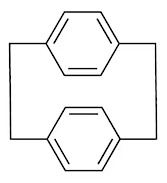
Edit: As @Texium has pointed out below, what Sigma-Aldrich sells is a derivative of [2.2]paracyclophane, and not the long-named compound I have drawn
previously. The structure above is the correct one.
There's also 4,4-carbonyl dibenzoic acid.
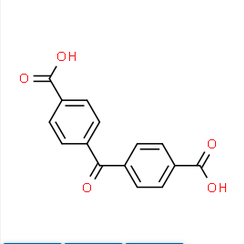
Alkaline hydrolysis of clear PET from a water bottle
And the latest developments of my ongoing experiment with alkaline hydrolysis (using the recipe presented in [1]) are quite interesting too. The
reaction has sped up about 3 days ago. The pieces of PET that were slowly dissolving some weeks ago are for the most part gone, and the remaining few
look like thin shredded plastic film. There's a deposit of disodium terephthalate at the bottom of the polypropilene vial.
I took some pictures and, despite the quality being too low, I'll share them as promised about a month ago. They were taken today. The coin is a 10
yen coin (23.5 mm in diameter). The engravings in its reverse help to focus the bloody camera Samsung has been using in some of their smartphones.
The first and second pictures, taken about one month apart, show the deposit of salt (presumably disodium terephthalate) at the bottom of the
saturated solution. Notice the existence of two layers with different colors. The upper layer's yellowish tint is due to a speck of crap that fell
into the vial when I was filling it and dissolved right away before I could curse or remove it. The lower layer, as white as boric acid, appeared
after the rate of hydrolysis increased. The solution smells funny, quite like glycerol.
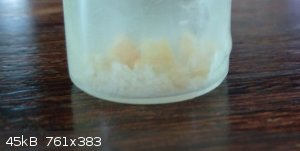 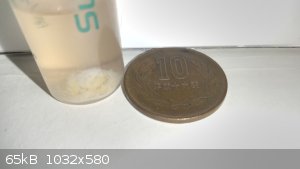
The third picture shows a crystaline mass that had formed in a corner of one of the PET pieces. I reported its formation about a month ago. It has
grown to the size shown since then.
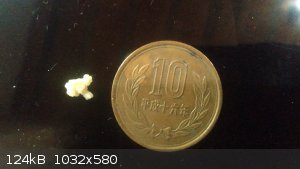
The fourth picture shows the crystaline mass after maceration in ethanol azeotrope. The alcohol was heated almost to boiling and tiny crystals, not
discernible in the picture thanks (again) to the guys at Samsung, have precipitated on cooling. The inset on the upper right corner can give a rough
idea.
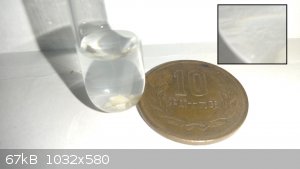
The fifth picture shows a badly attacked piece of PET floating in water. The surface is finely grooved and some regions were torn apart or shredded by
the solution. I removed it as a sample after seeing it was the first one to "give up", about one month ago. The fourth picture shows the same piece of
polymer in a darker background.
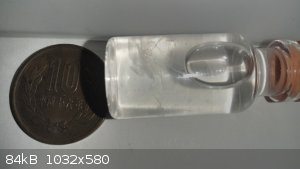 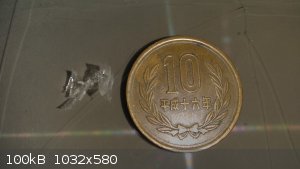
Laziness and a splitting headache prevent me (for now) from going further and precipitating terephthalic acid from an aqueous solution of the salt. A
previous test with a small sample (10 mg or so of salt) showed the formation of a milky emulsion, with particles so small that the time they took too
to settle down was beyond my boredom limits. I'll try to rig a centrifuge tomorrow or the next day and do it.
I don't have an NMR spectroscope, or access to one, for that matter. My laboratory has been in a regretful state of disrepair for almost a decade,
concomitantly with my being broke most of the time.
[1] Sibel Ügdüler et al. Towards closed-loop recycling of multilayer and coloured PET plastic waste by alkaline hydrolysis, Green Chem.,
2020, 22, 5376-5394. https://pubs.rsc.org/en/content/articlehtml/2020/gc/d0gc0089...
[Edited on 10-4-2024 by bnull]
Quod scripsi, scripsi.
B. N. Ull
P.S.: Did you know that we have a Library?
|
|
|
Texium
Administrator
       
Posts: 4516
Registered: 11-1-2014
Location: Salt Lake City
Member Is Offline
Mood: PhD candidate!
|
|
The structure you linked to on Sigma
is called [2.2]paracyclophane (the structure you drew is missing the ethylene bridges between the rings). One of my coworkers has actually been trying
to access these starting from terephthalaldehydes for the last 3 years and is close, but still not quite there. Seeing the grief he’s gone through
even with excellent resources at his disposal, I’d say it’s not an amateur-friendly synthesis.
|
|
|
palico
Hazard to Self
 
Posts: 59
Registered: 1-10-2013
Member Is Offline
Mood: No Mood
|
|
Quote: Originally posted by Hexabromobenzene  | Terephalic acid is of little interest. In theory, p-hydroxybenzoic acid or p -xylenediol by electrochemical reduction can be made from it. The
p-diaminobenzole can also be made from this acid
However, these compounds are of little interest. Are there any partial decarboxylation methods of terephtallic acid into benzoic acid? For example,
pyrolysis sodium terephtalate sodium with lime. Or isomerization to o-phthalic acid |
The interest of terephtalic acid is to make PET. The PET hydrolysis I have presented is a form of chemical circular recycling, which transforma a
waste in its precurso material, from which new virgin PET can be made. Mechanical recycling is instead difficult and resulting PET has different
physico-chemical properties than starting one.
@bnull: thanks for your contribution. Yes that is paracyclophane, it is quite hard to synthesize.
|
|
|
| Pages:
1
2 |
|